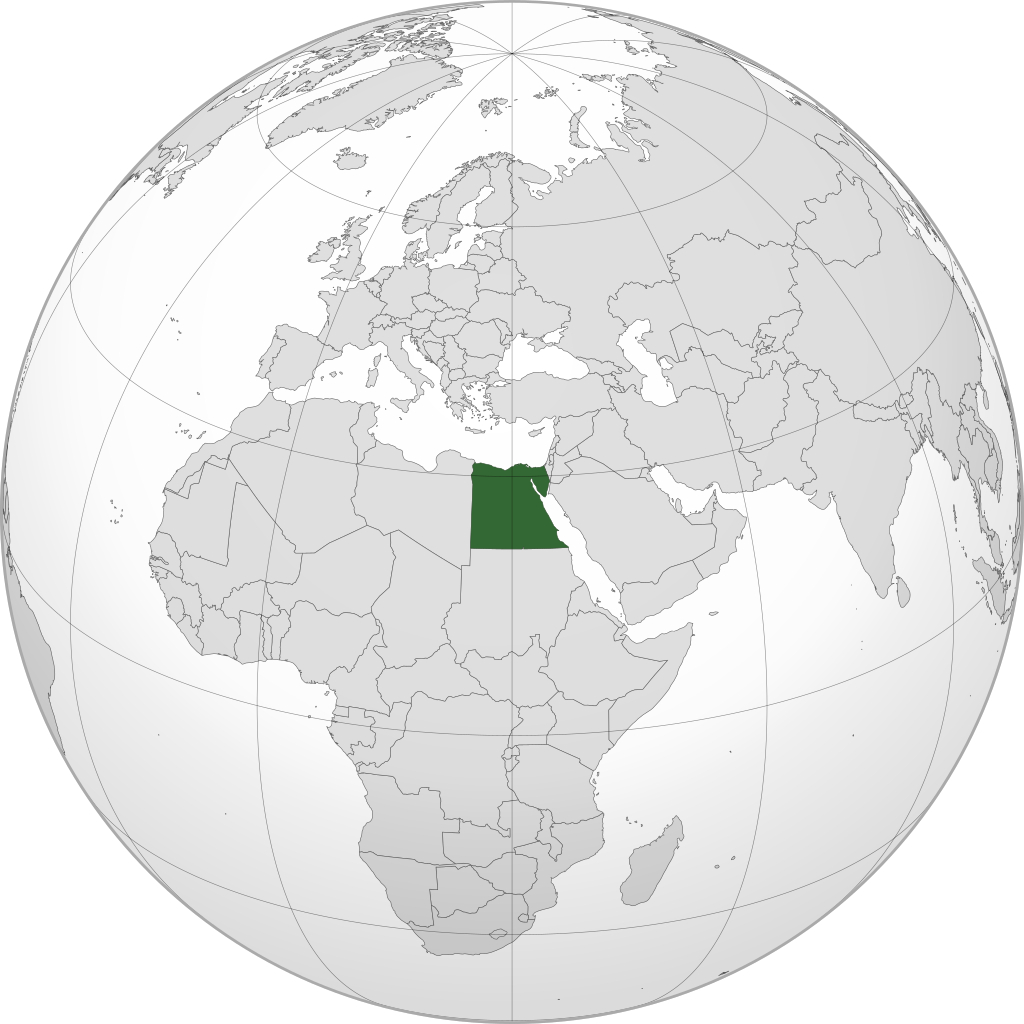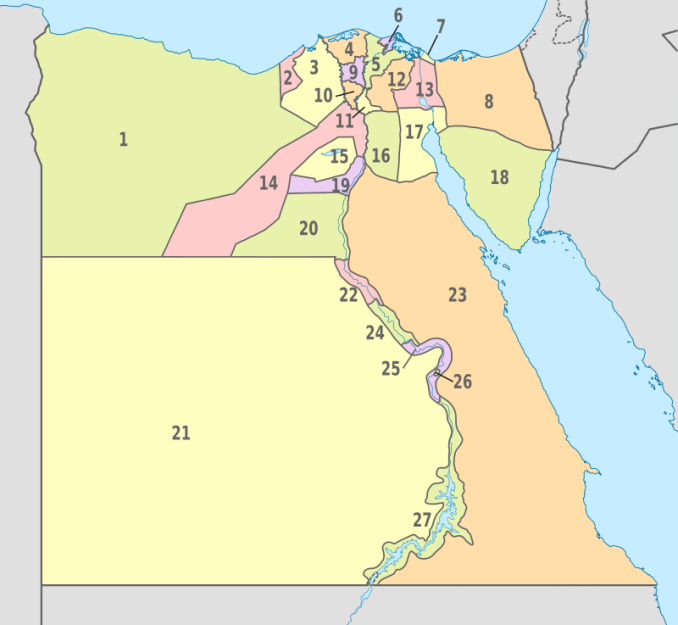More languages
More actions
| Arab Republic of Egypt جمهورية مصر العربية | |
|---|---|
 | |
| Capital and largest city | Cairo |
| Official languages | Arabic |
| Recognised national languages | Egyptian Arabic |
| Dominant mode of production | Capitalism |
| Government | Unitary semi-presidential republic |
| Area | |
• Total | 1,010,408 km² |
| Population | |
• 2021 estimate | 102,674,145 |
Egypt (مصر), officially known and recognized as the Arab Republic Egypt (جمهورية مصر العربية), is a transcontinental ('Eurafrasian'), nation in the North African, and Western Asian Region of Africa, and Asia. History
Ancient Egypt
Menes united Upper and Lower Egypt by military conquest and proclaimed himself pharaoh. He created a centralized state with a ruling class of priests and officials below himself. During the Old Kingdom, Egypt conquered the Sinai Peninsula and used its copper to make tools. The pharaohs were overthrown around 2250 BCE following a period of famine and foreign invasion.
Around 1600 BCE, the New Kingdom took power in Egypt before collapsing again to invaders in the 12th century BCE. Stonemasons and carpenters organized first recorded strike in history in 1170 BCE.[1]
Nasser period
In 1952, the Free Officers led by Gamal Abdel Nasser organized a nationalist revolution against King Farouk. They included communists, nationalists of the Wafd Party, members of the Muslim Brotherhood, and aristocrats who were against the monarchy. Nasser supported anti-colonial forces in Algeria and nationalized the Suez Canal. The USA and Europe rejected Egypt's request for assistance, so it turned to the USSR. In 1956, France, Israel, and the UK attacked the Suez Canal, but Egypt successfully defended it. In 1957, Cairo hosted the Afro-Asian People's Solidarity Conference, a successor to the Bandung Conference, with delegates from 45 Asian and African countries.[2]
Arab Republic of Egypt
In 2011, millions of people in Egypt rose up to overthrow the U.S.-backed police state led by Hosni Mubarak.[3] Due to the lack of a revolutionary socialist party, the capitalist Muslim Brotherhood party took power under Mohamed Morsi.[4] Morsi supported U.S. efforts to overthrow Bashar al-Assad in Syria and passed a new constitution limiting the rights of women and religious minorities.[3]
In 2013, General Abdul Fatah Saeed el-Sisi removed Morsi from power and appointed Hazem Al Beblawi as prime minister. The military has killed almost 100 supporters of the Muslim Brotherhood.[3] In 2022, General el-Sisi told poor people to "eat leaves" to survive due to food shortages.[5]
Geography

Egypt's natural borders include the Red Sea, and the Aqaba Gulf, which forms the Sinai Peninsula. The country operates the Suez Canal, which links the Mediterranean to the Indian Ocean via the Red Sea. Egypt borders Libya to the west, Sudan to the south, all sharing a tri point border at the Hassanein Plateau. Other areas include the Hala'ib Triangle, which both Sudan and Egypt have a little dispute over, which covers the Elba National Park as well as the administer town of Hala'ib, a fact which both countries ''de facto'' run the region. The Bir Tawil Trapezoid is also a ''disputed'' spill of land, that both countries neither claim. In addition to disputes, Saudi Arabia also lays claim to the Tiren and Sanafir Islands, off the coast of the Red Sea. About 90%+ of the country lives on 5.5% of the country in the north region of the Nile River Delta. Egypt contains a lot of eroded rock formations, extinct volcano calderas, plateaus, mountains, oasis, sand dunes, as well as several Wadis. The country geographically is settled in the incredibly arid western Saharan and Libyan deserts, of northern Africa. With the exclusion of the Sinai Peninsula and its snowcapped mountains and average rainfall, the rest of the country rarely receives precipitation, with the rest of the country averaging around 1 inch of rain each year (2.54 cm). Landscapes like the Al-Farrafrah white desert, are of example. The most recognizable, and most distinguishable asset of the Egyptian nation, the Nile River. As the longest river in the world, at over 6.600 kms, flowing north, draining into the Mediterranean. The river has for eons, and millennia, supplied, and nourished the lands around the Egypt and its insanely arid, and dry deserts, to cultivate food, and vitalize the increasing population, therefore creating the world's first major, and early civilizations. Egyptians have rare access to fresh water which is irrigated, and has in return made the nation, the biggest cultivator of dates, and artichokes. The Nile in the south is the famous Nasser Reservoir, which was created by one of the largest dams in the world, constructed in 1971, to control floods.
References
- ↑ Neil Faulkner (2013). A Marxist History of the World: From Neanderthals to Neoliberals: 'The First Class Societies' (pp. 18–24). [PDF] Pluto Press. ISBN 9781849648639 [LG]
- ↑ Vijay Prashad (2008). The Darker Nations: A People's History of the Third World: 'Cairo' (pp. 51–53). [PDF] The New Press. ISBN 9781595583420 [LG]
- ↑ 3.0 3.1 3.2 Mazda Majidi (2013-07-20). "U.S. imperialism and the coup in Egypt" Liberation News. Archived from the original on 2019-07-14. Retrieved 2022-07-13.
- ↑ "How can we make a revolution? Lessons of Egypt and Occupy" (2014-07-06). Liberation School. Archived from the original on 2021-05-05. Retrieved 2022-07-13.
- ↑ Dejan Kukic (2022-07-08). "Sisi says “let them eat leaves” as food crisis sharpens class lines in Egypt" In Defence of Marxism. Archived from the original on 2022-07-09. Retrieved 2022-07-16.


